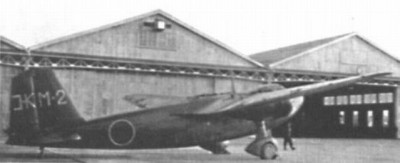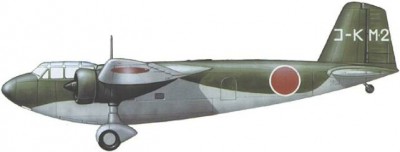| Název: Name: | Micubiši K7M1 | Mitsubishi K7M1 |
| Originální název: Original Name: | 十一試機上作業練習機 | |
| Kategorie: Category: | cvičný letoun | trainer aeroplane |
| Výrobce: Producer: | DD.MM.1938-DD.MM.1938 Mitsubishi Heavy Industries, Ltd., Nagoya | |
| Období výroby: Production Period: | DD.MM.1938-DD.MM.1938 | |
| Vyrobeno kusů: Number of Produced: | 2 | |
| První vzlet: Maiden Flight: | DD.MM.1938 | |
| Osádka: Crew: | 2 + 7 | |
| Základní charakteristika: Basic Characteristics: | ||
| Vzlet a přistání: Take-off and Landing: | CTOL - konvenční vzlet a přistání | CTOL - conventional take-off and landing |
| Uspořádání křídla: Arrangement of Wing: | jednoplošník | monoplane |
| Uspořádání letounu: Aircraft Concept: | klasické | conventional |
| Podvozek: Undercarriage: | pevný | fixed |
| Přistávací zařízení: Landing Gear: | kola | wheels |
| Technické údaje: Technical Data: | ||
| Hmotnost prázdného letounu: Empty Weight: | 2550 kg | 5622 lb |
| Vzletová hmotnost: Take-off Weight: | 3800 kg | 8378 lb |
| Maximální vzletová hmotnost: Maximum Take-off Weight: | ? kg | ? lb |
| Rozpětí: Wingspan: | 20,000 m | 65ft 7,39in |
| Délka: Length: | 13,260 m | 43ft 6,04in |
| Výška: Height: | 3,460 m | 11ft 4,21in |
| Plocha křídla: Wing Area: | 50,30 m2 | 541.42 ft2 |
| Plošné zatížení: Wing Loading: | 75,55 kg/m2 | 15.47 lb/ft2 |
| Pohon: Propulsion: | ||
| Kategorie: Category: | pístový | piston |
| Počet motorů: Number of Engines: | 2 | |
| Typ: Type: | Gasuden GK2 Tempu 11 (Ha-22-11) vzduchem chlazené hvězicové devítiválce o vzletovém výkonu 250 kW (340 k), nominální výkon 221 kW (300 k) v h= 0 m Vrtule čtyřlisté dřevěné s pevným úhlem náběhu o průměru 2 200 mm | Gasuden GK2 Tempu 11 (Ha-22-11) nine-cilinder air-cooled radial engine rated 335 hp at take-off and 296 hp at sea level, driving a four-blade fixed-pitch wooden propellers of 7 ft 2.61 in diameter. |
| Objem palivových nádrží: Fuel Tank Capacity: | 490 l | 107.8 UK gallons |
| Výkony: Performance: | ||
| Maximální rychlost: Maximum Speed: | 259 km/h v 0 m | 160.9 mph in 0 ft |
| Cestovní rychlost: Cruise Speed: | 180 km/h v 1000 m | 111.8 mph in 3281 ft |
| Rychlost stoupání: Climb Rate: | ? m/s | ? ft/min |
| Čas výstupu na výšku: Time to Climb to: | 14,83 min do 3000 m | 14,83 min to 9843 ft |
| Operační dostup: Service Ceiling: | 5800 m | 19029 ft |
| Dolet: Range: | 926 km | 575.4 mi |
| Maximální dolet: Maximum Range: | ? km | ? mi |
| Výzbroj: Armament: | 1x pohyblivý zdvojený kulomet Type 92 ráže 7,7 mm ve hřbetním střelišti. Pumový náklad do 90 kg (3x 30 kg) | One flexible twin 0,303 in Type 92 machine-guns in dorsal turret. Bombs: up to 198lb. |
| Uživatelské státy: User States: | - | - |
| Poznámka: Note: | 11机 十一試機上作業練習機 / Džu-iči Ši-Ki-Džó sagyó renšú-ki / Námořní experimentální letoun pro výcvik osádek 11-Ši | 11机 十一試機上作業練習機 / Jū-ichi Shi-Ki-jō sagyō renshū-ki / Navy Experimental 11-Shi Crew Trainer |
| Zdroje: Sources: | Shigeru Nohara, The Xplanes of Imperial Japanese Army & Navy 1924-45, Green Arrow, Japan rok 2000 Tadeusz Januszewski a Kryzysztof Zalewski: Japońskie samoloty marynarski 1912-1945, tiel 2., Lampart, rok 2000, ISBN 83-86776-00-05 L+K 22/1989, Letadla 1939 - 45 http://www.samoloty.ow.pl/str068.htm archiv autora | |
Micubiši K7M1 11-Ši
- / - / -
11机上作业练习机 / - / Naval Experimental Trainer 11-Shi
History:
In 1938, two prototypes of the K7M1 were ready for flight testing. The prototypes of these aircraft were the Mitsubishi Jukogyo Kabushiki Kaisha factory's response to the 11-Shi technical specifications issued by Kaigun Koku Hombu. The competition featured single-engine prototypes of the Kawanishi K6K1, Watanabe K6W1 and Mitsubishi K6M1. The K7M1s were twin-engined and were truly modern training machines with an all-metal construction, intended to replace the old Mitsubishi K3M in service.
Internal spaces were used efficiently and training could be conducted with several students at the same time. For bombardier training there was a bombsight. For live training, three 30 kg bombs could be dropped, a total of 90 kg bomb load could be carried. For deck gunners, there was a firing range at the end of the cabin with one 7.7 mm machine gun. The entire aircraft design bore the hallmarks of the aircraft that the Mitsubishi factory produced as combat aircraft e.g. the G3M bomber.
The two prototypes of the K7M1 proved to be very successful in courier and transport missions, but mass production did not take place, despite the complete satisfaction of the Naval Air Force with this type of aircraft, the reason for not putting it into production was the insufficient production capacity of the Mitsubishi factory and also the fact that the Watanabe factory had already begun design work on the Shigaraku aircraft.
The two K7M1 prototypes were flown by the Yokosuka Kokutai unit, but were not recorded by Allied intelligence and so were not assigned a code name. The Naval Air Force primarily used the old modified Mitsubishi G3M Nell bombers for multi-engine crew training, only much later was a special Kyushu K11W1 Shigaraku trainer introduced into production, which was also less complex in terms of mass production, yet just as effective as the K7M1.
This post has not been translated to English yet. Please use the TRANSLATE button above to see machine translation of this post.
| Period | - |
| Producer | - |
| Type | - |
| Camouflage | - |
| Country | - |
| Pilot | - |
| Production No. | - |
| Serial No. / Evidence No. | - |
| Tactical Marking / Imatriculation | - |
| Name | - |
| Unit | - |
| Base | - |
| Date (DD.MM.RRRR) | - |
| Author | - |
| Print size / 300 DPI | - |
| Published with authors permit | - |
| Author Website | - |
This post has not been translated to English yet. Please use the TRANSLATE button above to see machine translation of this post.
| Period | - |
| Producer | - |
| Type | - |
| Camouflage | - |
| Country | - |
| Pilot | - |
| Production No. | - |
| Serial No. / Evidence No. | - |
| Tactical Marking / Imatriculation | - |
| Name | - |
| Unit | - |
| Base | - |
| Date (DD.MM.RRRR) | - |
| Author | - |
| Print size / 300 DPI | - |
| Published with authors permit | - |
| Author Website | - |
This post has not been translated to English yet. Please use the TRANSLATE button above to see machine translation of this post.
| Period | - |
| Producer | - |
| Type | - |
| Camouflage | - |
| Country | - |
| Pilot | - |
| Production No. | - |
| Serial No. / Evidence No. | - |
| Tactical Marking / Imatriculation | - |
| Name | - |
| Unit | - |
| Base | - |
| Date (DD.MM.RRRR) | - |
| Author | - |
| Print size / 300 DPI | - |
| Published with authors permit | - |
| Author Website | - |
Join us
We believe that there are people with different interests and experiences who could contribute their knowledge and ideas. If you love military history and have experience in historical research, writing articles, editing text, moderating, creating images, graphics or videos, or simply have a desire to contribute to our unique system, you can join us and help us create content that will be interesting and beneficial to other readers.
Find out more

